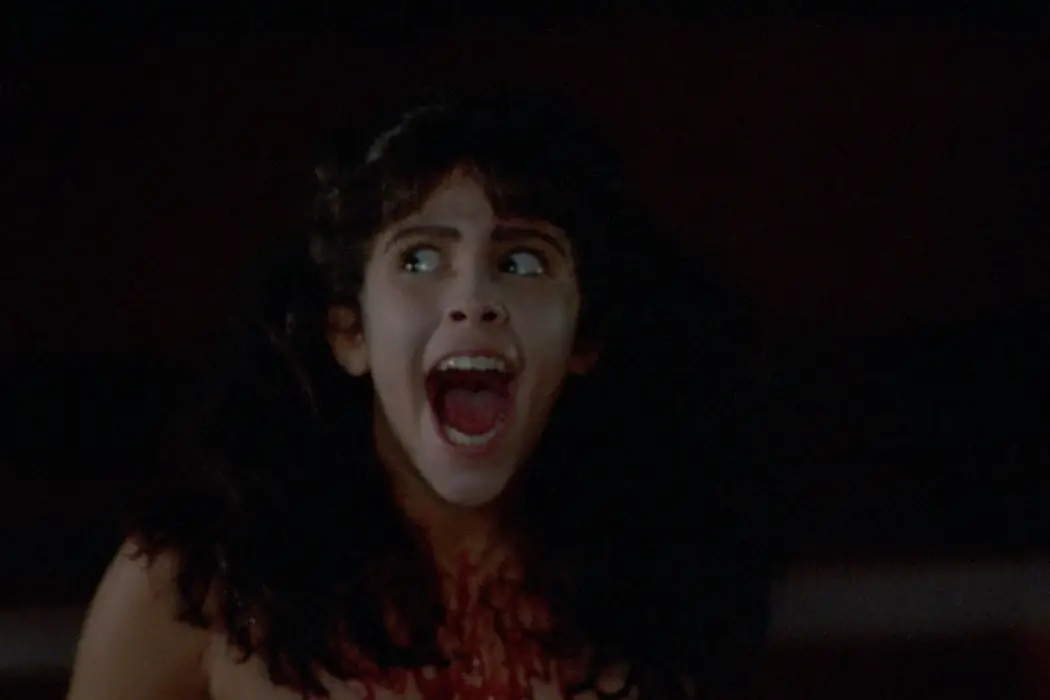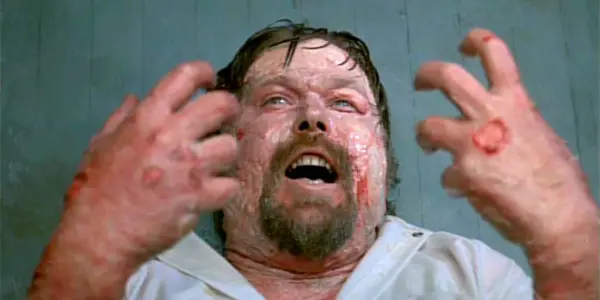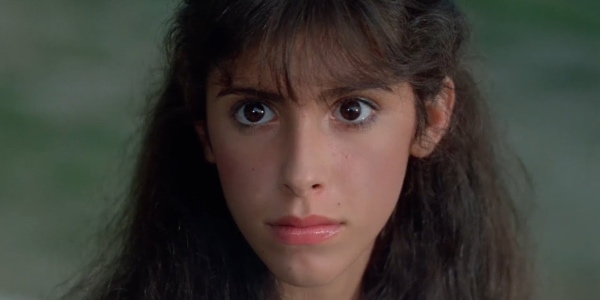Horrific Inquiry: SLEEPAWAY CAMP (1983)

Stephanie Archer is 39 year old film fanatic living in…
Welcome back to the newest, and at times goriest, column here at Film Inquiry: Horrific Inquiry. Twice a month, I will be tackling all things horror, bringing two films back into the spotlight to terrify and frighten once more. And occasionally looking at those that could have pushed the envelope further. Join us as we dive deep into the heart of horror, but warning, there will be spoilers.
Ah, the feelings of summer. Beaches, warmth, and for many, summer camp. In the heart of summer, it seemed like the perfect time to finally watch Sleepaway Camp, a fill that resonates both summer and horror – even at its worst moments.
And while Sleepaway Camp, from writer and director Robert Hiltzik, is far from the best horror film, it is proof that sometimes the payoff at the end is worth the entire venture.
Summertime Horror
Sleepaway Camp is a far cry from Crystal Lake and the terrorizing horror of Jason and his mother – both in quality and terror. Honestly, from the film’s opening panning shots of the camp that will eventually become the film’s setting, as a viewer, you know what you are getting yourself into. Sleepaway Camp seems aware of its deficiencies early on as it welcomes nostalgic Hitchc*ck-esque music, its brass instrument rifts, and Rear Window feel accompanying the panning that fills too large a portion of the first few minutes. Eventually, the film settles on two young children fighting on a boat. As their father comes into view, the young kids express their desire to water ski like the older kids on the other side of the lake.

While the father gives the hope promised within “maybe when you are older”, the camera introduces audiences to the teenagers in the motorized boats. The water skier is panicking and unsure, while on the boat the young girl convinces the driver to give her a chance at the wheel. As to be expected, she becomes distracted driving her boat into the father and his children. With as little gore and display as possible, the film relays the tragic deaths of both the father and one of the children.
Flashing forward 8 years, audiences learn that the young girl, Angela (Felissa Rose) was the only survivor of the boating accident, now living with her cousin Ricky (Jonathan Tiersten) and her eccentric Aunt Martha (Desiree Gould) – and is about to attend the camp she and her brother had inquired about just before the accident. She is no longer the child filled with hope and wonderment, but rather a silent and reserved young adult, still wearing the grief and scars of her past.
Up to this point, the dialogue and acting have left much to be desired – that is until you meet Aunt Martha. Over-exaggerated and overdramatic, her performance seems more appropriately positioned for a bad stage act, not one for the film. What is interesting is that the film will reference her a few more times throughout its run time, each time giving more plausibility to the performance and to her unusual behavior. What starts off as a possible aftermath of grief quickly escalates into something more unintentionally sinister and unnerving.
As soon as they arrive at the camp, much of the focus is on Angela. She remains quiet and disassociated from everything around her. She is a stationary figure and the film capturing those around her. The counselors who find her behavior socially unacceptable, the chef who looks to take advantage, the cousin always ready to jump in and save her – she stands still as the world revolves around her. It is an interesting viewpoint on the individual vs the world. We have the freedom to be what and how we choose, it is the world s opinions that swarm and swell around us, constantly pushing for conformity in behavior and belief.

As the swarming camp around Angela pushes and pulls at her sanctuary of self, those who go too far begin dropping like flies. While most violence and aftermath are shown off-screen, there are mutilated and distorted hands thrown in the air to show the pain and the horror, each becoming more violently carried out than the last. It’s a comforting nostalgia as it resonates with early horror films, capturing the horror of the present and the past in cinematic creation.
Examination of Societal Expectations of Woman
Sleepaway Camp, with the exception of its incredible shock ending, is honestly a terrible film. Yet, even in the worst of films, there are observations that can be made in regards to how things once were, the progress we have made since the film’s release, and how much further we have still to go. To understand where we are, we must look to the past. With Sleepaway Camp, viewers are given a look at the treatment and societal expectations of women during the early 1980s. Many times I found myself disgusted, other times recognizing behaviors all too often are still present.
As campers first arrive, a group of men, consisting mainly of kitchen personnel, comment on the “fresh chickens” as the camera cuts from them to the young girls running past. As the chef licks his lips, his assistant chef remarks that “they are too young to understand what’s on your mind.” Not that it would be wrong or inappropriate, just that they are too young to understand – to which the chef responds “there is no such thing as too young.” Where horror captures the darkest essence of reality and humanity, here, the objectification of women and youth is accepted in a less than subtle display of pedophilia. While the chef’s thoughts and behaviors are eventually punished through the scalding of boiling water (an almost act of cleansing), he lives, failing to meet the death typical of offenses in horror. And those around him that failed to tell him he was wrong or to report him, are left to promising careers. For the young women and children, they remain just objectified “young chickens”.
Furthering the examination, Sleepaway Camp delivers stereotypical projections of women – catty, jealous, and playing hard to get. When first arriving at camp, Ricky is told “wait until you see Judy”, his friend indicating the size of her boobs. Unfortunately, the film is not only speaking of her biological changes but the psychological changes Judy (Karen Fields) has gone through now that her body has taken form. It shouldn’t surprise you that Judy is the catty, jealous and promiscuous teen girl of the camp. Her advancement into puberty and her poor behavior is implied to go hand in hand. Her friend, Meg (Katherine Kamhi), is also shown as catty, jealous, and promiscuous, but more so in regards to luring the camp owner into an inappropriate relationship. Together, they terrorize Angela – and together they represent the film’s primary embodiment of feminity.

For a moment, Paul (Christopher Collet) seems to be the one decent young gentleman on the campus – minus the boob comment about Judy (but boys will be boys, right?). It doesn’t take long for him to be reminiscent of Bo Burnham’s Ryan from Promising Young Woman, his sweet attention to Angela turning more into pressure. He kisses her gently, and while he apologizes and asks for another, does not wait for her to answer before kissing her again. Bringing her to the beach, he tries to put the moves on her, Angela saying no – to which he responds by calling her a “bitch”. Because as a woman, by not allowing him to have his way, it is at the fault of Angela because she is difficult and uncooperative. It is for this reason that his death is the film’s most violent and attached to its most shocking reveal.
Examination of the viewpoint on the LGBTQ+ Community
Sleepaway Camp may be an excellent examination of the perspective and expectations of women, but it is just as much so for the roles and inclusion of the LGBTQ+ community of the time. Honestly, I was shocked to see its inclusion and heartbroken to see how it was originally intended. The film alludes (though very clearly as it continues on) that Angela’s father was gay and living secretly with his partner. While modern viewpoints see the boating accident as simply that, in the warped mind of the genre, the boating accident was brought on by his “inappropriate” relationship. It’s heartbreaking, but not uncommon for horror films to take a societal “no” and deter it through horror, violence, and death – most commonly, with teenage sex and drug use.
And while there are the expected and hurtful uses of the word “queer” throughout to identify someone who is different, what I found most intriguing was the retrospectively progressive viewpoint on the trans community. As the film reveals in a shocking conclusion, Angela was in fact the little boy who had survived the boating accident, not the girl. Her Aunt Martha had made her become a girl “because they already had a little boy” (i.e. her cousin Ricky). The film speaks to the mental and emotional toll being forced into a gender can take and how it escalates. Here, Angela allows the repression of self, to stay quiet and reserved as to not reveal herself. As the murders progress and increase in violence, so too does the escalation of her mental and emotional turmoil. She is reaching a point where she can no longer take or want to take being forced into the gender she had no choice of. She breaks free in a terrifying reveal, almost demonic in nature as her screams unnerve any viewer – a scream that has been building since she was a child.

While having this representation within a horror film lacks sensitivity due to the nature of its subject matter, there is still an essence of acceptability that can be drawn from the film retrospectively. Angela is forced to live a lie, to live as someone else. She knows she is a boy, and while the biological aspect plays in here, it does not change the fact that she was forced to live a life in a form that she did not choose and she did not identify with. In the 1970s and 1980s, conversion therapy and a war on marriage, coupled with the growing AIDs epidemic, too many had to hide themselves, their true selves – and desires.
Where once this was a warning, a horrific depiction of what is to come if you lean into a gender that is not yours (by choice or by force), today, Sleepaway Camp can retrospectively be examined as not only this perspective but also the debilitating effects that can occur both mentally and emotionally by being forced to deny that with which we truly identify.
Conclusion: Sleepaway Camp
While Sleepaway Camp may be one of the worst quality horror films, it is not without its takeaways. Many present themselves as viewpoints of the treatment and expectations within a time period, while others have been reshaped with time, retrospectively advancing the film and our understanding of the past vs. the present. If this isn’t enough to peak your interest, then Sleepaway Camp’s shocking conclusion makes it all worth it.
What are your thoughts on Sleepaway Camp? Let us know in the comments below!
Watch Sleepaway Camp
Does content like this matter to you?
Become a Member and support film journalism. Unlock access to all of Film Inquiry`s great articles. Join a community of like-minded readers who are passionate about cinema - get access to our private members Network, give back to independent filmmakers, and more.













